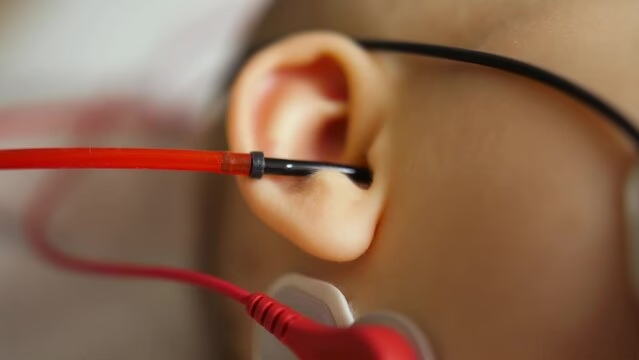Hearing plays a vital role in communication, learning, and overall development, especially during the early stages of life. That is why advanced audiology diagnostic services are essential in detecting hearing difficulties at the earliest stage possible. Two of the most widely used techniques in modern hearing evaluations are the ABR test (Auditory Brainstem Response) and the ASSR test (Auditory Steady-State Response). Both assessments provide accurate insights into how the auditory system is functioning, making them valuable tools for patients of all ages, particularly infants and newborns.
What is an ABR Test?
The auditory brainstem response test, often referred to as the ABR test, is a non-invasive procedure that evaluates how well sound signals travel from the ear to the brainstem. Small sensors are placed on the scalp and earlobes to measure the brain’s activity in response to different sounds.
This method is especially useful when performing a hearing test for infants or individuals who cannot respond verbally during traditional hearing checks. Parents often find reassurance in the fact that the ABR hearing assessment can detect even subtle levels of hearing loss.
Understanding the ASSR Test
Another advanced option in hearing diagnostics is the auditory steady-state response test, also called the ASSR test. This evaluation uses continuous sound stimuli and measures the brain’s electrical activity to determine hearing thresholds across different frequencies.
One of the advantages of the ASSR test is its ability to provide frequency-specific information, making it highly effective for creating a detailed hearing profile. For patients with more complex hearing needs, this test offers an additional layer of precision compared to other screening methods.
Why Early Detection Matters
Detecting hearing loss as early as possible allows children to receive timely support, ensuring their language, learning, and social development are not delayed. Hospitals and clinics often include newborn hearing screening as part of their standard health checks to ensure that any issues are identified quickly.
If initial results suggest potential hearing concerns, follow-up with specialized diagnostic methods such as the ABR test or ASSR test can confirm the extent of hearing loss and guide further treatment.
Audiology Diagnostic Services for All Ages
Modern audiology diagnostic services are designed to cater to a wide range of patients, from newborns to older adults. These services go beyond simple screenings and involve comprehensive evaluations, which may include:
- Newborn hearing screening shortly after birth.
- ABR hearing assessment to measure brain responses to sound.
- ASSR test for detailed hearing thresholds.
- Counseling and guidance on hearing solutions such as hearing aids or other interventions.
By combining these tools, audiologists ensure patients receive the most accurate diagnosis and personalized care.
What to Expect During a Hearing Evaluation
Many parents or patients feel nervous about diagnostic tests, but both the ABR test and the ASSR test are safe and comfortable. For infants, these evaluations are often conducted while the child is asleep. The sensors used in these tests are painless and simply record brainwave activity in response to sounds.
The process typically involves:
- Preparing the patient with small electrodes on the scalp and earlobes.
- Playing different tones or clicks through headphones or earphones.
- Monitoring brain responses to measure auditory function.
Since these methods do not require active participation, they are especially beneficial for babies or individuals with developmental challenges.
ABR vs. ASSR: Which Test is Better?
Both tests serve unique purposes, and audiologists often decide based on the patient’s age, medical history, and type of hearing concern.
- The ABR test is often the preferred method for newborn hearing screening and quick evaluations because of its reliability in identifying whether sounds are reaching the brainstem.
- The ASSR test is typically used when more detailed, frequency-specific information is needed, making it ideal for fitting hearing devices or confirming complex hearing patterns.
In many cases, both tests complement each other to give a clearer picture of a patient’s hearing abilities.
Supporting Families Through the Process
Undergoing a hearing test for infants or any advanced evaluation can feel overwhelming for parents. That’s why professional clinics offering audiology diagnostic services focus not only on the technical side of testing but also on providing guidance, emotional support, and practical solutions.
Families are often counseled about the importance of early intervention, treatment options, and how hearing care can positively influence a child’s communication and development.
Conclusion
The ABR test and ASSR test represent two of the most effective methods in modern hearing evaluation. Whether used in newborn hearing screening or as part of a comprehensive ABR hearing assessment, these tools help audiologists provide accurate diagnoses and timely interventions. By relying on advanced audiology diagnostic services, families can ensure their loved ones receive the care and support they need to lead fulfilling lives with healthy hearing.







